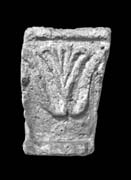Select a site alphabetically from the choices shown in the box below. Alternatively, browse sculptural examples using the Forward/Back buttons.
Chapters for this volume, along with copies of original in-text images, are available here.
Object type: Capital
Measurements: H. 20.5 cm (8 in); W. 13.3 > 11.5 cm (5.2 > 4.5 in); D. 25.5 > 17.3 cm (10 > 6.8 in)
Stone type: Very pale orange (10YR 8/2), sparry matrix supported, shelly oolite with many hollow ooliths. Oolith size 0.2 to 0.6 mm. Some shell debris up to 10 mm. Bedding pick out by shelly concentrations parallel to vertical axis of capital. Possibly Taynton Limestone Formation, Great Oolite Group, Middle Jurassic.
Plate numbers in printed volume: Ill. 248; Fig. 22E
Corpus volume reference: Vol 10 p. 202
(There may be more views or larger images available for this item. Click on the thumbnail image to view.)
Capital, cut back to a straight edge on both sides for reuse in pigeon house. The capital has a projecting half-round moulding along the top and a flatter, slightly wider moulding along the bottom that projects 2 cm (0.8 in) from the face. The face of the capital curves in slightly towards the bottom moulding. The front face of the capital carries a foliate decoration in relief 0.6–0.9 cm (0.2–0.4 in) deep.
This capital originally had a curving, cone-shaped profile, very similar to some of the tenth- or early eleventh-century capitals reused in the eastern slype at Worcester Cathedral (e.g. Worcester Cathedral 3b and 3f, Ills. 678, 682). The decoration consists of an acanthus-like fan of broad, fleshy leaves springing from two trailing loops that curve up on either side of the central fan of leaves. These trailing strands originally continued around onto the sides of the capital, and there is just enough surviving carving beside the cut-back sides to suggest that they probably terminated in spirals. Zarnecki suggested a late eleventh-century date for the carving (Price 1980, 79), but if the shape of the capital is also taken into account a date in the first half of the eleventh century seems more likely.
At the time of the Domesday Survey, Frocester was a possession of Gloucester Abbey (Moore 1982, no. 10,2). In a late-medieval list of benefactions Gloucester Abbey claimed to have been given Frocester by a brother of King Beornwulf of Mercia (823–5), but there is a clear anomaly for the donor has the distinctively Scandinavian name of Ravenswart (Hart 1863–7, i, 77). Frocester seems to have been the site of a minor minster (Gray 1963; Blair 2005, 190 n. 33).



